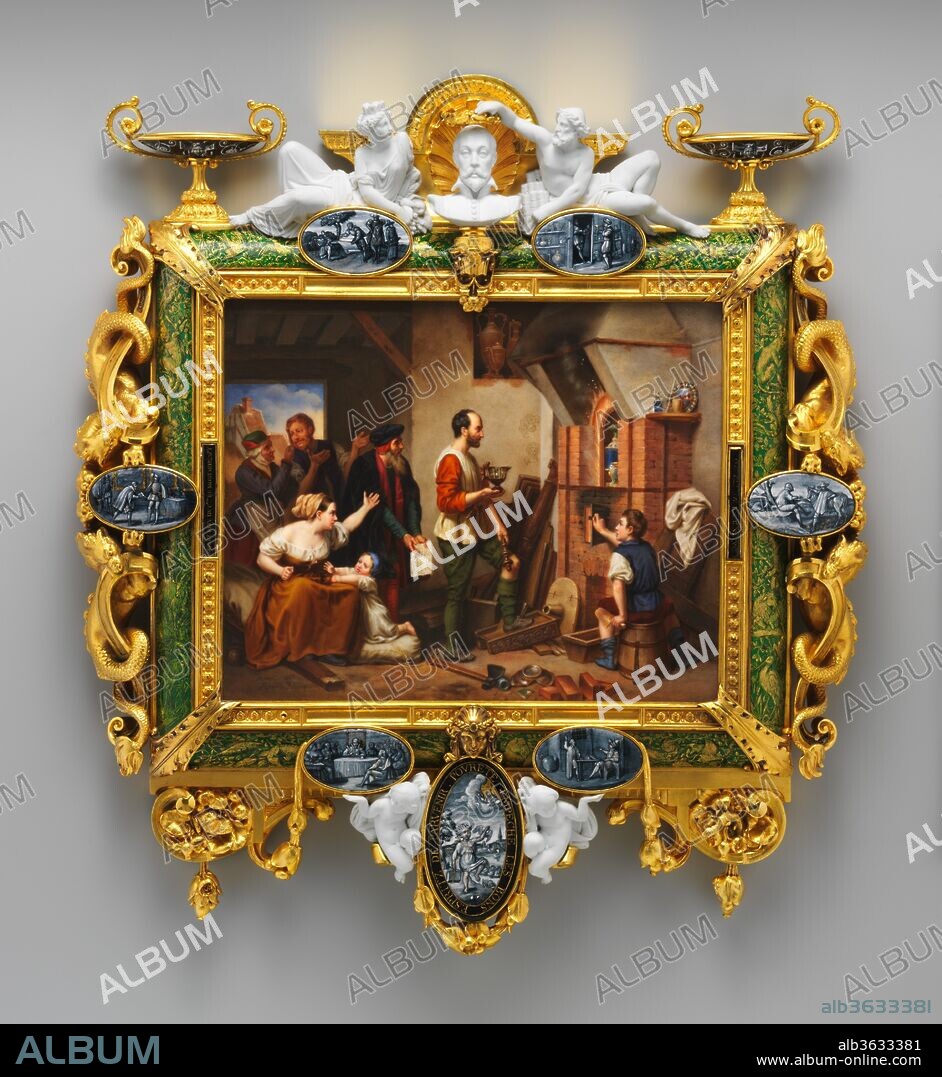alb3633381
AFTER A PAINTING BY CHARLES ALEXANDRE DEBACQ. Plaque depicting Bernard Palissy

|
Add to another lightbox |
|
Add to another lightbox |



Buy this image.
Select the use:

Title:
Plaque depicting Bernard Palissy
Caption:
Plaque depicting Bernard Palissy. Artist: After a painting by Charles Alexandre Debacq (French, Paris 1804-1853 Paris). Culture: French, Sèvres. Designer: After a design by Nicolas-Marie Moriot (French, Versailles 1788-1852); After designs by Alexandre Laemlein (French, Hohenfeld 1813-1871 Pontlevoy). Dimensions: Overall (confirmed): 19 1/2 x 17 3/4 x 2 5/8 in. (49.5 x 45.1 x 6.7 cm). Enameler: Enamel decoration by Jacob Meyer-Heine (active 1840-73). Maker: Frame by Armand Feuchère (French, active Sèvres, 1842-51). Manufactory: Sèvres Manufactory (French, 1740-present). Modeler: Biscuit figures modeled by Jean-Baptiste-Jules Klagmann (French, Paris 1810-1867 Paris). Date: 1846.
This framed Sèvres plaque is one of the most ambitious and original works of art produced in the Renaissance Revival style of mid-nineteenth-century France. Both the plaque and the elaborate frame pay homage to the flourishing of the decorative arts that took place during the French Renaissance. The scene on the plaque, by Nicolas-Marie Moriot after a painting by Charles Alexandre Debacq (1804-1853), portrays Bernard Palissy, the only Renaissance potter whose name was known in the nineteenth century, burning the furniture in his house to fire his kiln. The oval enamel-on-copper plaques that decorate the frame depict events from Palissy's life, and their grisaille decoration evokes Limoges enamels of the sixteenth century. The plaques were painted by Jacob Meyer-Heine, who was name head of the recently established enamel workshop at Sèvres in 1840. The dragons entwined with strapwork on the gilt-bronze frame by Armande Feuchère are drawn from the architectural vocabulary of the French Renaissance, and the biscuit porcelain figures modeled by Jean-Baptiste-Jules Klagman (1810-1867) recall the stucco decoration of the Galerie François I at Fontainebleau, the supreme example of Renaissance art in France. The designs and molds for this plaque are preserved at the Sèvres manufactory.
Technique/material:
Hard-paste porcelain; biscuit porcelain; enamel; gilt bronze
Museum:
Metropolitan Museum of Art, New York, USA
Maker:
Frame by Armand Feuchère (French, active Sèvres, 1842-51)
Credit:
Album
Releases:
Image size:
3865 x 4200 px | 46.4 MB
Print size:
32.7 x 35.6 cm | 12.9 x 14.0 in (300 dpi)
Keywords:
AFTER A PAINTING BY CHARLES ALEXANDRE DEBACQ • ARTFORM: BRONZEWORK • BISCUIT • BRONCE • BRONZE BRASS • BRONZE • BRONZES • CERAMICS • CERAMICS-PORCELAIN • CLAY • COPPER ALLOY • ENAMEL • EUROPE • EUROPEAN SCULPTURE AND DECORATIVE ARTS • FRAME BY ARMAND FEUCHÈRE (FRENCH, ACTIVE SÈVRES, 1842-51) • FRANCE • GILT • GLASS PASTE • GLASS • HARD PASTE PORCELAIN • HARD-PASTE PORCELAIN; BISCUIT PORCELAIN; ENAMEL; GILT BRONZE • METAL • METROPOLITAN MUSEUM OF ART, NEW YORK, USA • ORMOLU • PLAQUES • PLATE • PORCELAIN • SÈVRES
 Pinterest
Pinterest Twitter
Twitter Facebook
Facebook Copy link
Copy link Email
Email
